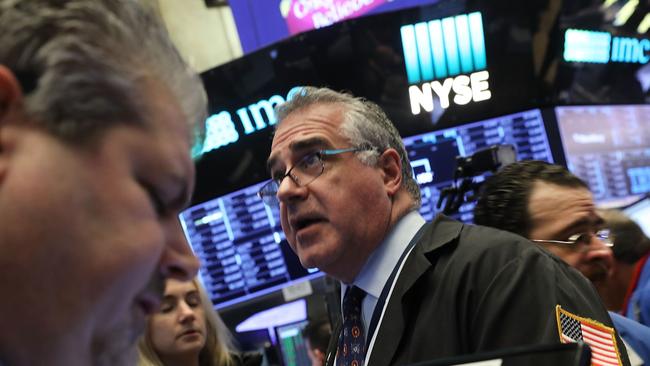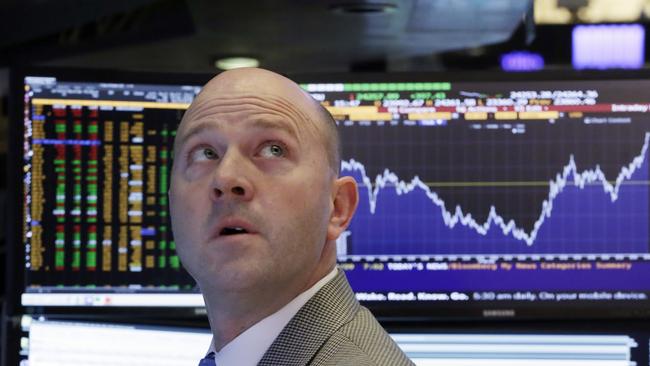Global share market slump reflects volatile times
THE world is awash with too much debt — especially government and household. And it’s all been balanced on very high share and property values. So we have volatile times ahead, writes Terry McCrann.
Terry McCrann
Don't miss out on the headlines from Terry McCrann. Followed categories will be added to My News.
WELL, at least we managed to finish the week knowing one thing clear and indisputable about the global market turmoil — it isn’t a replay of 1987. Or, for that matter, 1929.
Last Sunday — writing after Day One and the first “wobble on Wall St” overnight Friday — and before our market had felt any of the cold chill — I ventured it would not be a replay. Now we know it as a fact.
In October 1987, Wall St dropped 4 per cent on the Friday and then a mind-boggling 22.6 per cent on the Monday. More than a quarter of the entire value of all the shares in the US evaporated all but instantly over just two days.
BAREFOOT INVESTOR: SUN WILL STILL RISE
STOCK MARKET’S WORST WEEK IN TWO YEARS
This time around, the Friday drop — while we slept Down Under — was “only” a little over 2 per cent.
Despite Monday recording the biggest point fall in more than 140 years of Wall St trading, the percentage fall was “only” a little over 4.6 per cent.

The two-day drop sliced about 7 per cent from US share values; and remember, that was the share value which had previously risen by 44 per cent since the election of Donald Trump in November 2016. And even before Trump, had already risen spectacularly.
Even if we add on the impact of the second 1000-point fall for the week, the total losses only reached 10 per cent — and that’s before offsetting them with the two days of big recoveries, including the one on the last day of the week.
The other big difference is that in 1987, immediately on Day One, the once “Great 1980s Entrepreneurs” — the Bonds, the Holmes a Courts, the Skases and a few dozen other lesser names that have faded into history — began teetering and toppling. And our banks were preparing for big losses.
There has been no sign of that. Indeed, in the middle of the week the CBA put out its profit with nary a sign of (potential) 1980s-style losses.
The other reason, for good measure, why it wasn’t 1987 redux, is that share market crashes are supposed to only happen in October. That’s when the 1929 Great Crash was also.
Last week, I also ventured that it would not be a replay of 2008, and the Global Financial Crisis — which did plunge the entire world (except us and a couple of others) into the worst economic downturn since the 1930s — either.
While the proof of that prediction will only play out over time, the core point to remember is the root cause of the market slump was precisely, if indirectly, the opposite: that we face the best global economic conditions since before the GFC.
It finally, really, dawned on US investors that the good economy is going to bring with it higher interest rates.
The combination is good and indeed desirable — we’ll get something more akin to normality for savers and workers (and business) alike.
But it’s not great for overvalued share prices, which have been driven up by near-global zero interest rates and trillions of dollars of central bank-created money.
So, no 1987-style crash and no GFC. But that is not to say there can’t or won’t be stormy waters ahead.
The world is awash with too much debt — especially government and household. And it’s all been balanced on very high share and property values.
In a very broad sense we are now more acutely in a race between the good economic times creating real income which can service the debt and being overwhelmed by the rising interest rates on the debt which will follow as central banks raise short rates and markets increase long rates.
Even if we hadn’t had the week we’ve just had, that should have been ringing a very loud bell that it was time to fasten financial seatbelts for a year of Force Five Volatility.
But not to figuratively hide under the proverbial bed: we’ve got volatile times ahead, not dismal to awful times.

Further, share market (and bond market) volatility mostly hurts speculative and professional investors and traders. It’s also the greatest wealth-making opportunity for those who are smart (or lucky).
Overnight Friday on Wall St was a pretty good example, It was looking grim, especially after Thursday’s repeat 1000-point fall.
For most of the day the market looked like it was putting together another 1600-point or so two-day slump when the Dow went 500 points into the red. It ended up over 300.
Bottom line: there’s never a totally free lunch. The global economy is going to deliver good economic times (and thank goodness: we ain’t doing too much to create them for ourselves).
The relatively small negative is share market volatility, and probably a market that in overall terms heads sideways or down, maybe 10-15 per cent.


